products categories
- Battery Production Equipment Line
- Battery Lab Pilot Equipment Line
- Lithium Battery Pack Assembly Line
- Solid State Battery Assembly Line
- Sodium Ion Battery Production Line
- Supercapacitor Assembly Line
- Lithium Ion Battery Recycling Plant
- Dry Electrode Preparation Solution
- Perovskite Based Solar Cell Lab Line
- Li ion Battery Materials
- Cathode Active Materials
- Anode Active Materials
- Customized Battery Electrode
- Coin Cell Parts
- Lithium Chip
- Cylindrical Cell Parts
- Battery Current Collectors
- Battery Conductive Materials
- Electrolyte
- Metal Mesh
- Battery Binder
- Separator and Tape
- Aluminum Laminate Film
- Nickel Strip
- Battery Tabs
- Graphene Materials
- Nickel Felt
- Titanium Fiber Felt
- Battery
- Battery Pack Machine & Compoments
- Battery Pack Compoments
- Turnkey Solutions Battery Pack Assembly Line
- Cell Sorter
- Battery Pack Spot Welder
- Laser Welder
- Battery Charging Discharging Tester
- Battery Pack Aging Machine
- Battery Pack Comprehensive Tester
- CCD Visual Inspector
- Battery Pape Sticking Machine
- BMS Testing Machine
- Al Wire Bonding Machine
- Lithium Battery Machine
- Battery Tester & Analyzer
- Battery Safety Tester
- Material Characterization Tester
- Rolling Press Machine
- Spot Welding Machine
- Vacuum Mixer Machine
- Crimping/Disassembling Machine
- Vacuum Sealing Machine
- Electrolyte Filling
- Stacking/Winding Machine
- Electrode Cutter/Slitter
- Pouch Forming Machine
- NMP Solvent Treatment System
- Lithium Battery Production Plant
- Vacuum Glove Box
- Furnaces
- Coaters
- PVD Coater
- Laboratory Press Machine
- Large Press Machine
- Planetary Centrifugal Mixer
- Ball Mill
- Laboratory Machine
- Cutting Machine
- Metal Foam
contact us
- If you have questions, please contact us, all questions will be answered
- WhatsApp : +86 18659217588
- Email : David@tmaxcn.com
- Email : Davidtmaxcn@gmail.com
- Add : No. 39, Xinchang Road, Xinyang, Haicang Dist., Xiamen, Fujian, China (Mainland)
-
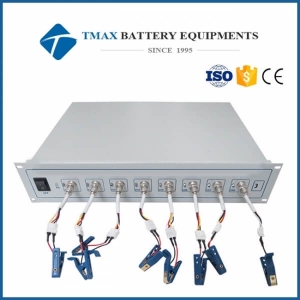 5V5mA 8 Channel Button Coin Cell Battery Test Analyzer With DCIR Testing
5V5mA 8 Channel Button Coin Cell Battery Test Analyzer With DCIR Testing
-
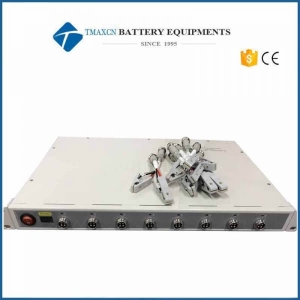 5V10mA 8 Channel Coin Cell Battery Tester Analyzer
5V10mA 8 Channel Coin Cell Battery Tester Analyzer
-
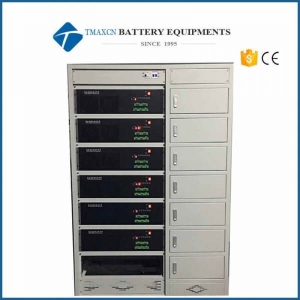 30V20A Battery Testing Equipment
30V20A Battery Testing Equipment
Battery tester equipment is a battery analyzer to analyze polymer battery and cylindrical batteries. This battery test system provides most applications in battery testing fields such as electrode materials research, battery performance test, small-scale battery formation, capability grading, battery pack testing and etc.
-
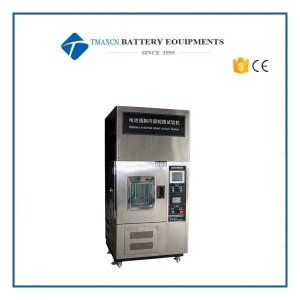 Laboratory Battery Internal Short Circuit Testing Machine for Lithium Battery R&D
Laboratory Battery Internal Short Circuit Testing Machine for Lithium Battery R&D
-
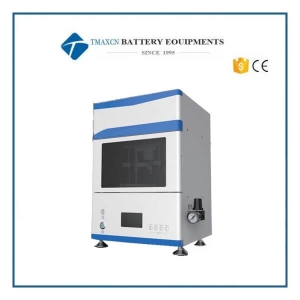 Battery Electrode Resistance Analyzer Machine for Lithium Battery Testing
Battery Electrode Resistance Analyzer Machine for Lithium Battery Testing
Battery Electrode Resistance Analyzer Machine for Lithium Battery Testing The importance of electrode resistance Electrode resistance (conductivity) influences the basic performance of batteries, not only on the power capability (internal resistance), but also on the reliability or safety performance. Through the measurement of electrode resistance the property of electric conductive, micro-structural uniformity of electrodes can be evaluated during die electrode many&manu&cture process in advance, thus help us to research and improve the formulation of composite electrodes as well as the control parameters of mixing, coating and calenderii^; processes. In the composite electrodes, the electric conductivity is determined by several primary factory, such as the inter&cial resistance between the coating layer and the conductive foil, the distributions of conductive agents, die intrixisic resistance of active material and the contact areas between particles. The functions of BER multi-function electrode resistance analysis method for electrode process monitoring are listed as follows: Comprehensively assessment of the slurry stability from the stirring, coating to the calendering process, which helps to recognize die anomaly aggregation of conductive agents in advance; Recognition of uneven mixing on mixture silicon—carbon cathode; Assessment of dectric conductivity offonnulas for diferent active materials; Assessment of electric conductivity of formulas for diferent conductive agents; Assessment of electric conductivity of the functional pre—coating lays of current collector; Failure analysis for the electric conductive networic failure of batteries; Analysis of contact resistance of the positive or negative electrode sur&ce after formation. The limitations of traditional test methods Currently, there are several methods have been used to test the electrode resistance, such as four point probe method or multi point probe method and single point probe method. Though these traditional methods may have been maturely used in di&rent types of film industry areas, for the evaluation of the composite electrode films in lithium ion batteries, there are still several deficiencies that can not be ignored. The four point probe film resistance test method has been wildly used in thin films industries, which use four or even more probes array to test the film resistance form film sur&ce. Its test procedure is easy and simple, and it can reveal the anisotropic resistance components of thin film by a simple equivalent circuit model fitting. However, considering its test principle and model fitting process, this mediod can only be suitable for a uniform thin film with smooth sur&ce, and the test sample should be loaded on an insulating substrate for ideal resistance fitting. Unfortunately, the electrodes ofliduum ion batteries are composite electrode with complex compositions, rough sur&ce and loadit^ on a low resistance current collector, so their four point probe test data, are often inconsistent and difficult to analyze the result by theoretical models. Increasing die probe number and using more complicate models can improve the test reliability to a certain extent, but that need more complex structures, and again the result analysis is still difficult. The single point test method was another wildly used method in the lithium ion batteries industry, which use a fixed probe on the end of the curtent collector and a mobile probe on the surface of the electrode to directly measure the electrode resistance. This is a very simple way of electrode resistance test often carry out by a homebuilt system for difierent users, but it is still a rough empirical test method without considering the influence of press pressure, conductive path length, substrate materul and so on. As a result, the single point probe method can not provide a reliable and consistent electrode resistance data as well. Methods Four point probe test Single point probe test Electric test circuit Kelvin four-wire test technology + direct current stimulation Kelvin four-wire test technology + alternating-current Probe structure four assembled equidistant probes (< ® 1mm), which's tops are kept in the same plane during the test to get a physical contact with the sample surface One probe (usually is an alligator clip) is fixed on the current collector, and the other probe (usually is a Cu terminals) is mobile to contact on the sample surface Applicable samples Single component thin layer material with smooth surface Composite electrode with current collector Advantages and limitations √ Simple and fast measurement √ To reveal the anisotropic resistance components of thin film X Not suitable for composite electrode with current collector √ Simple and fast measurement √ Suitable for composite electrode with current collector x X A rough empirical test method without considering the influence of press pressure, conductive path length, substrate material, etc. * Developed with CATL the top power battery company and Authorized exclusively for the Patent. The TMAX’s creative solution The BER series Battery electrode resistance analyzer uses the upper and lower plane controllable pressure probes to directly measure the electrode to obtain the overall resistance and resistivity in the thickness direction of the electrode, including the contact resistance between the probe and the coating, the coating resistance, and the contact resistance between the coating and the current collector. Current collector resistance; The BER series is the first Battery electrode resistance analyzer for the lithium battery industry . The dual—plane controllable—pressure high—conductivity probe designed for composite electrode diaphragms and micron—level flat surface treatment ensure measurement accuracy; the high-precision resistance resolution and the attached calibration module ensure stable and reliable measurement results. Introduction of principles Multi-function One — stop data collection of key parameters including pressure, film resistance, film thickness, temperature, humidity, etc.; guarantee the reliability and traceability of measurement result. Automatic measurement Automatic measurement of the resistance under different pressure, thickness, temperature and humidity, etc.; provide a real time data display. Professional processing software *Provides various resistance measurement and analysis methods, including Single point test, continuous test, *Fixed pressure mode, variable pressure mode (ForBER1300) Show data curve *Different presented modes of data analysis and statistics. Integrated design Complete integration of pressure control module, resistance and voltage measurement module, thickness measurement module and the chamber illuminating module Device Four-probe and multi-probe methods BER series Principle Kelvin four-wire method+DC excitation Kelvin four-wire method+AC excitation current Structure Four taper equidistant probes in the same Φ14 mm copper terminals located at the upper and lower Suitable Single-component film with smooth surface(non-battery electrode) Thick composite material(battery electrode) with resistance Features Measure single-component film resistance and conductivity or smooth surface Measure the resistance and conductivity of the battery electrode, adjustable test pressure Conclusion 1.The traditional test method does not consider the influence of parameters such as pressure and contact area during the electrode test, and the theoretical calculation model of the multi-probe is quite different from the actual sample, and the data results are uncontrollable; 2.The BRE series electrode resistance meter can accurately control the test parameters such as test pressure and area to ensure stable and reliable results, and can directly obtain the corresponding relationship between the electrode compaction and the electrode resistance. *Developed with CATL the top power battery company and Authorized exclusively for the Patent Software Measurement system analyze *Part of the data comes from the partners, and the copyright belongs to the relevant parties. It can not be reproduced or used without consent. Applications Material evaluation 1.Correlation between powder conductivity and electrode conductivity Results Analyze Adjust the Ni content in the NCM material, and test the powder conductivity. It can be found that as the Ni con tent increases, the powder conductivity increases; Comparing three NCM pieces with different Ni content, it can also be obtained that as the Ni content increases, the conductivity of the electrode piece increases; Powder resistivity and electrode have the same trend! 2.Evaluate the resistivity of uncalendered electrode pieces under different compaction densities Conditions: 5-60MPa, step 10MpPa, keep 25s Results Analyze ♦ For graphite electrode, with the increase of compaction density, the resistivity continues to decrease. The reason is that the contact between active materials increases, and the overall conductivity of the electrode becomes better; ♦ For NCM electrode, with the compaction density increases, the resistivity of the pole piece continues to decrease. The main reason is that as the pressure increases, the contact between terminals and the active material becomes better; Process evaluation 1.Evaluation of electrode primer technology <a> The thicker the primer, the greater the resistance of the current collector; <b> The thicker the primer, the greater the cathode resistance; <c> After determining the best primer coating process based on the correlation between the two, the electrode resistance test can be used as a method for long-term monitoring of process stability. 2.Conductive agent distribution uniformity evaluation By monitoring the change use the resistance of the battery electrode, an abnormal battery electrode can be quickly identified, to prevent the bad battery electrode from flowing into the next process, and to save production costs. Cell evaluation 1.Analysis of electrode resistance during high temperature cycle&storage *The resistance of the cathode continues to increase with the increase in the number of cycles, indicating that a large change has taken place on the cathode side after the high temperature cycle, which may be related to the byproducts on the surface of the cathode particles or the contact between the particles; *The resistance of the anode membrane increases with the storage time, which indicates that the anode side has changed a lot during the storage process, which may be related to the increase of side reactions on the anode material surface *Part of the data comes from the partners, and the copyright belongs to the relevant parties. It can not be reproduced or used without consent. Parameter Resistance range 1uΩ-3.1kΩ Resistance accuracy ±0.5%FS Pressure range 50-600kg/5-35MPa(BER2100/BER2200) 50-1000kg/5-60MPa(BER2300/BER2500) Pressure accuracy ±0.3%F.S Thickness range 0-5mm(BER2500) Thickness resolution/accuracy 0.1um/±1um(BER2500) Temperature and humidity 0-50℃, 20-90%RH Temperature and humidity accuracy ±2℃, ±5%RH Installation requirement voltage 200-240V/50-60Hz Voltage variation tolerance ±10% Power dissipation 50W(BER2100/BER2200)/450W(BER2300/BER2500) Air source Pipeline gas or air compressor is required(BER2100/BER2200) Environmental temperature 25±5℃ Environmental humidity Humidity <80%RH at the temperature of 40℃ Environmental magnetic field Keep away from intense electromagnetic Net weight 76kg(BER2100/BER2200), 83kg(BER2300), 85kg(BER2500) Dimension(W*D*H) 355*320*550 mm(BER2100/BER2200) 355*320*800(BER2300/BER2500) Note: TMAX is committed to continuous improvement of products. TMAX reserves the right to alter the specifications of its products of its products without notice. All trademarks are registered by TMAX. Model BER2100 BER2200 BER2300 BER2500 Press mode Cylinder(pipeline gas required, range: 5-35MPa) Servo motor(No pipeline gas required, range: 5-60MPa) Testable parameters Resistance, pressure Temperature and humidity Resistance, pressure Temperature and humidity conductivity, resistivity Resistance, pressure temperature and humidity conductivity, resistivity Resistance, pressure Temperature and humidity conductivity, resistivity thickness, compaction density Function One point test Constant pressure condition Included BER2100 function Automatic measurement software Included BER2200 function Variable pressure Included BER2300 function Thickness measurement Compaction density measurement
-
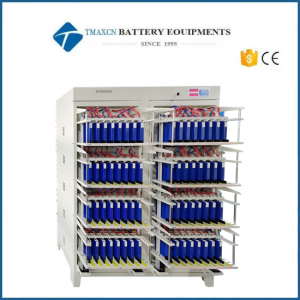 5V 10A 196 Channel Battery Tester Charging and Discharging Machine for Prismatic Battery
5V 10A 196 Channel Battery Tester Charging and Discharging Machine for Prismatic Battery
-
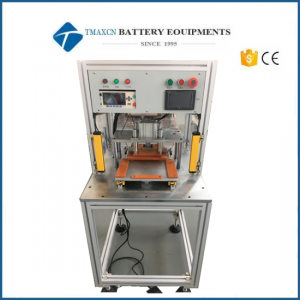 OCV Sorting and Testing Machine For Prismatic Battery Production
OCV Sorting and Testing Machine For Prismatic Battery Production
-
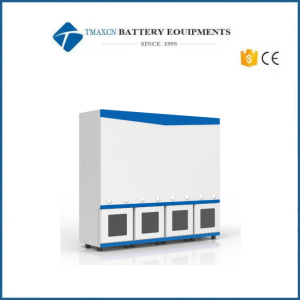 Lab 4 Channels Lithium-ion Battery In-Situ Swelling Testing Machine
Lab 4 Channels Lithium-ion Battery In-Situ Swelling Testing Machine
Lab 4 Channels Lithium-ion Battery In-Situ Swelling Testing Machine Expansion Behavior of Lithium-ion Batteries During the process of charging and discharging, the the intercalation and deintercalation of Li-ion in the electrodes will cause the lithium-ion batteries (LIBs) to expand and shrink. Ideally, the volume change of the material during the lithium intercalation/deintercalation should be reversible. However, in is always a fraction of lithium ions that cannot be completely unembedded from the electrodes or deposited on the anode surface as insoluble byproducts during the cycle. This will cause irreversible expansion of the LIBs and serious consequences, such as: the deformation of the jelly roll, the rupture of the material particle, the break and regeneration of the solid electrolyte interphase (SEI) which constantly consume the electrolyte. Therefore, the expansion behavior of LIBs has become a very important reliability issue in the application of lithium-ion battery, and it needs to be considered in the design of battery structure, particle size, adhesive and electrode structure of anode materials. for the next generation anode materials with higher energy density,, such as silicon and lithium metals, the expansion problem will be much more serious than graphite. Therefore, an accurate and effectivetool for evaluating the expansion behavior of LIBs can effectively the development and optimization of the silicon-based anode and lithium metal anodes. Moreover, on the aspect of pack design, the expansion evaluation of LIBs can also improve the utilization rate of the pack space under the premise of safety. Traditional Test Methods Introduction of Multi-channel In-situ Swelling Analyzer Application Cases 1. In-situ expansion test of model buckle cell Cell parameters:Button full battery (NCM811 / SiC), capacity of about 3 mAh; Experimental parameters of in-situ expansion:Setting the current is 0.3 mA, voltage interval is 2.5~4.2V,running for three circles, and recording the relative expansion thickness of the full coin cell synchronously; Experimental result: The full coin cell expands / shrinks with the charge / discharge process, and the inflection point of the voltage curve in the three cycles is highly consistent with the inflection point of the thickness expansion curve, indicating that the expansion thickness curve can effectively reflect the volume change in the process of the intercalation and deintercalation of Li-ion.. The average variation of the relative thickness is about 0.00167mm, and the COV of the expansion thickness is only 2.82%, indicating the good cycle consistency of the model coin cell. Note: COV (Coefficient of Variation) = (standard deviation sigma) / (mean mean) 2. In-situ expansion test of multi-layer stacked cells: Cell parameters:Multi-layer stacked ba tery (NCM811 / SiC), with a capacity of about 400 mAh; Experimental parameters of in-situ expansion:Three parallel samples, synchronously test the percent expansion thickness at a constant pressure of 0.1MPa; Experimental result: The multilayer stacked battery expands / contracts with the charge / discharge process, and the two cycles maintain good repeatability. The maximum expansion ratio is about 12%, and the expansion thickness COV of these three groups of cells is 1.5%, indicating a good agreement among these parallel samples. 3. In-situ expansion test of the pouch cell: Cell parameters:Multi-layer pouch cell (NCM811 / SiC), capacity of about 400 mAh; Experimental parameters of in-situ expansion:Three parallel samples, synchronously test the percent expansion thickness at a constant pressure of 0.1MPa; Experimental result: The pouch cell expands / shrinks with the charge / discharge process, and the two cycles maintain good repeatability. The maximum expansion ratio is about 4%, and the expansion thickness COV of these three groups of cells is 1.4%, indicating a good agreement among these parallel samples. Model Specifications Model MSWE1100 MSWE1200 MSWE1300 MSWE1400 Number of channels 4 Pressure regulation mode With counterweight Servo motor Pressure limit 0.5kg/1kg/5kg (customizable according to customer nees) 0-100kg Pressure accuracy ±0.01kg ±0.01kg/±0.3%FS Scope of thickness detection ±5mm Thickness detection resolution/precision 0.1um/±1um 0.01um/±0.1um 0.1um/±1um 0.01um/±0.1um Systematic error ≤3% Maximum cell size measurement 60*90*4mm(customized according to specific needs) Installation Requirements Model MSWE1100 MSWE1200 MSWE1300 MSWE1400 Source 220-240V/50-60Hz Voltage change tolerance ±10% Power consumption 20W 400W Ambient temperature 25±5C Ambient humidity ≤80%RH(no moisture condensation)
-
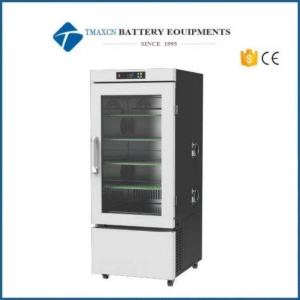 Battery Testing Machine Constant Temperature Test Chamber
Battery Testing Machine Constant Temperature Test Chamber
Battery vercharge-proof box testing machine
 English▼
English▼




 +86 13174506016
+86 13174506016 David@tmaxcn.com
David@tmaxcn.com

